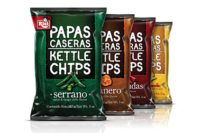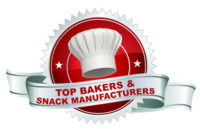
By Dan Malovany
Christian Perera has no problems preaching about hard work and dedication as the backbone to the success of any burgeoning business. Dedication, however, can be an issue when it comes to specializing in the production of custom-designed frozen desserts.
Rather, the vice president of operations at Starr Culinary Delights often has to rely on innovation when it comes to crafting mousse cakes, layer cakes, coffee cakes, cheesecakes and miniature treats. A bit of trial and error with a touch of out-of-the-box thinking tends to do the work on the production floor of this Mississauga, Ont., bakery.
Single-mindedness is not an option here.
“We just try to figure it out,” he says. “We don’t have lines dedicated to one product, and we do a lot of modifications to our lines to make sure everything works out more efficiently.”
The 100,000-sq.-ft. facility officially houses five production lines, but that’s not readily apparent because many of the depositors and topping systems are interchangeable. Because the pieces of a puzzle are constantly changing as Starr Culinary Delights routinely adds new products or improves the formulas on existing ones, the operation relies on modular stations and mobile equipment to transform square loafs into round ones or its signature cinnamon and chocolate coffee cakes into unique apple- or caramel-injected ones.
Strawberry or chocolate swirl cheesecake in a 9- or 6-in. size? At Starr Culinary Delights, it’s whatever the customer wants.
“We have taken equipment and not dedicated it to one idea or one item,” Christian says. “We have depositors that fit into many locations. It’s having a little bit more foresight into what you plan to do or can potentially do with a piece of equipment instead of saying ‘I’m only making coffee cakes on that one line.’ The lifestyle of a piece of equipment is much longer than the lifestyle of one product.”
The X-factor, he adds, is the human touch.
“We’re not afraid to have equipment do the job, but we’re going to add that hand element that a lot of equipment can’t change over to,” he explains. “Because we’re so versatile, and we’re doing so many different things, we need both. That’s our strength. Our customers will come to us and say, ‘I want a cake with all of these odds and ends to it,’ and we’re able to deliver that.”
Constantly Shifting Business
Production at Starr Culinary Delights can vary from a minimum of five days a week to 24/7, depending on the time of year with this seasonal business. Typically, bakers work around the clock, prepping products such as baking and freezing layers of cakes at night and using them as the foundation of mousse cakes, which are finished off during the day.
Production scheduling occurs around noon on the previous day, allowing the company to bring in ingredients, packages and pans for the next day’s work from a nearby warehouse, notes Markus Perera, systems manager. Because it produces hundreds of varieties of products, he says, Starr Culinary Delights has so many pan sizes that they have to be stored offsite. Only the ones used during a day’s production are brought to the bakery.
Not surprisingly, with such product variety, bulk ingredient handling is mostly nonexistent. Most ingredients come in 50-lb. bags or small totes. The bakery has one larger system to supply the 2,200 lb. of whole eggs that it uses daily.
Like its equipment, production is designed in a versatile, modular fashion. The multipurpose mixing room, for instance, houses a battery of 14 mixers ranging from 150 qt. on average to one, 500-qt. mixer. There, operators constantly are producing batters, fillings, icings and toppings for the adjacent makeup room.
Likewise, a separate room houses 11 double rack ovens, although the bakery has a 40-ft. tunnel oven for higher volume products such as cheesecakes. Starr Culinary Delights plans to add four more double rack ovens to keep up with increasing demand, especially during the peak holiday season.
In many ways, the semi-automated operation looks like a retail bakery on steroids. In fact, one part of the bakery is a large bench where several pastry chefs produce made-to-order specialty desserts that require significant hand makeup or difficult-to-automate products like mini-carrot cake shots.
“It all depends on what time of the day you show up here,” Markus says. “They could be making anything.”
On the mousse cake line, chocolate sponges baked the night before pass through a slicing station, which cuts them into two layers. DuringSF&WB’svisit, the frozen layer cake serves as the foundation for the chocolate mousse, which is deposited once and allowed to settle before a second depositing of mousse followed by hand garnishing with a variety of toppings.
After racking and traveling to a blast freezer, the mousse cakes make a U-turn on a conveyor to the packaging room, where desserts are shrink wrapped and cartoned or put on plastic plates and in clamshells with labels before passing through metal detection, case packing and palletizing. Overall, Markus notes, the line will produce about 3,500 cakes during an eight-hour shift.
Meanwhile, the bakery produces 2-in. round cheesecakes on its mini-product line. After operators add silicone papers to the bottom, the 48-piece pan receives oil spraying before a 16-nozzle depositor adds cream cheese batter. Bakers then add crumbs to the top of the pan before racking them and baking the cheesecake, in essence, upside down.
After cooking, the pans are placed on the conveyor, and there is an additional option to inject flavored fillings into the pieces. A needle depanner removes the cheesecakes while the silicone paper is vacuumed off the products, which then are packed manually by the dozen in plastic clamshells or paperboard cartons before metal detection and case packing.
The versatile coffee cake line can produce 20 varieties of products, Markus notes. After oiling, the pans travel through a dual-depositing marbling system, which deposits batter and cinnamon while spinning the pan to give it the marbled appearance. After streusel is automatically applied, the products receive a second spray of oil on the top before baking.
After baking, the coffee cakes pass through a dual spiral cooler, are manually depanned and injected with caramel. Other fillings such as chocolate, apple or lemon are available. The cakes are manually placed on black plastic plates and in clam shells before being labeled, metal detected, cartoned and frozen.
The line will produce between 30 and 50 pallets of product per shift, Markus says.
Expanding with Caution
The bakery also has a cheesecake line that’s slowly being automated. In the near future, Markus notes, an automatic crumb application system will be added, and the line already has a dual depositor marbling system. The line can produce swirl cheesecakes as well as multiple layered products. To ensure a moist crust, bakers place the cheesecakes on a baking sheet and then add water that’s eventually absorbed by the crumb.
After baking, the cheesecakes are blast frozen, sliced, cartoned and run through a metal detector before case packing. Previously, Markus says, 9-in. cheesecakes were most popular, but because of the slumping economy, Starr Culinary Delights has seen a spike in 6-in. varieties that provide a more affordable value proposition.
Products are stored in a 5,000-sq.-ft. holding freezer, which holds between 500 and 1,000 pallets, depending on the time of year and demand for its products. The company also has offsite cold storage. Common carriers or its customers directly ship product, but Starr Culinary Delights also has three trucks that provide daily deliveries in the Toronto metropolitan area.
Looking forward, the company had been planning to move to a larger facility, but that’s been put on hold for now, says Kelly Perera, Christian’s and Markus’ father and founder of Starr Culinary Delights.
“We always had great growth,” he says. “Next year, we were expected to go into a new plant and put everything under one roof, but we deferred plans and instead expanded the current facility to meet demands due to the growth of the company and to achieve optimization.”
Instead, the company is moving all of its administrative offices to a nearby 25,000-sq.-ft. building, which also will serve as a warehouse for ingredients, packaging materials and pans. With the move, the stand-alone production facility will have more than 100,000 sq. ft. of space.
Over the years, Christian adds, the company has not only learned from its customers and other businesses, but also developed a niche of a custom-baking products that is difficult for others to master.
“We’ve picked up a lot of what people are doing as far as best practices, but we stand alone in what we do, which is providing what our customers are looking more than anything else,” he says. “That’s what drives us.”
That drive for innovation, along with hard work and dedication, keeps the company growing during these economic times.


